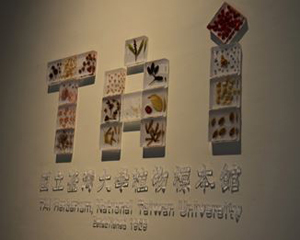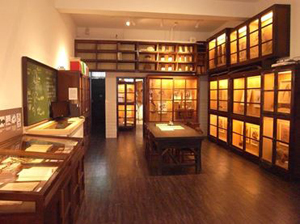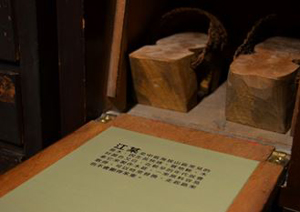:::
Legacies of NTU - No. 7
Preserving Nature’s Treasures: TAI Herbarium of NTU
 TAI Herbarium’s A small cabinet, that at first glance seems old and insignificant, sits quietly in an unlit corner inside one of National Taiwan University’s oldest buildings. Moving closer, one sees samples of Fagaceae fruits native to Taiwan lined upwards according to their vertical distribution above sea level, representing our island’s multitude of species and abundance of ecological characteristics. This is the TAI Herbarium of National Taiwan University.
 With its dated furniture and historical collection, the Herbarium exhibition room is filled with a sense of nostalgia.(Image: TAI Herbarium) Founded in 1927, the TAI Herbarium was established under the Faculty of Science and Agriculture at the Taihoku Imperial University (NTU’s predecessor) for research purposes. As the Herbarium joined the NTU Museums project, several exhibition areas dedicated to promoting its rich collection have gradually been set up inside and outside the Japanese-style building to be opened to the public.
Upon entering the Herbarium, one is immediately attracted to an arrangement of colorful platters lined in the letters “TAI,” and within each platter, seeds of various shapes and colors are placed, representing the Herbarium’s modern methods of preserving botanic specimens. Yet as one moves into the Exhibition Hall, a different story of history and ancient science unfolds.
The Herbarium’s main display area was re-organized and inaugurated in December 27, 2013. Although it was a new space, the room is filled with a sense of nostalgia as it is decorated with historical specimens and antique furniture that had been collected from various offices across the NTU campus.
 A pair of clogs made from the Schefflera Tree. The Schefflera is a common material for making clogs as the wood is light in weight and firm in texture Examples of these unique pieces are two humble-looking cabinets that were donated to the Herbarium by Professor Chang-Fu Hsieh (謝長富) of NTU’s Institute of Ecology and Evolutionary Biology. The cabinets had previously belonged to Professor Shinichi Hibino of the Japanese colonial period, and despite their unassuming exterior, the items are firm in structure and pragmatic in usage, which is exemplary of the Herbarium’s modest existence.
The Herbarium’s main display features an Exhibition Hall, a Special Exhibition Room, an Ethnobotany Room, and a Loan Box Center.
The Exhibition Hall is a small room filled with wooden furniture, dated books, and several strange-looking items. These items are the Herbarium’s wide collection of herbarium specimens, liquid specimens, freeze-dried specimens, and samples of fruit and wood. Each and every item in this less than 10-square-meter exhibition hall bears decades of historical significance.
In the Special Exhibition Room, the legacies of the Herbarium’s first curator, Yushun Kudo, are permanently displayed. These include manuscripts of his research as well as a wide array of his personal herbarium collections.
 Peanuts and other edible seeds. From the food we eat to the footwear we need, the Ethnobotany Room is another room filled with wonderful surprises as it features samples and explanations of various plants that are common to our everyday lives.
The Herbarium has also established a community outreach program in allowing educators to borrow “Loan Boxes,” which are teaching materials of Taiwan’s botanical knowledge condensed into a single suitcase. The outreach program is widely popular among educators and has helped cultivate interest in young students at an early stage of their education.
During the opening ceremony of the new display area in 2013, former NTU President Si-Chen Lee (李嗣涔) pointed out that the Herbarium has evolved from solely serving research purposes to expanding its duties to education and pedagogy. In addition to promoting NTU’s rich herbarium collection from Taiwan, Southeast Asia, and the Pacific islands, the TAI Herbarium shall continue to record and preserve nature’s treasured resources for all to enjoy.
For more information, visit the Herbarium’s official website, or click HERE to access original article written by the Agricultural Exhibition Hall (04/23/2014).
National Taiwan University is home to an abundance of educational and cultural artifacts that bear the history of the campus’ past. As a result, the NTU Museums project, a campaign that integrates the university’s ten individual museums, was launched in 2005 and officially inaugurated in 2007 so that the school’s hidden treasures could be introduced to the public. To honor the school’s past, the “Legacies of NTU” series will feature the stories of NTU’s hidden treasures by taking you through the most precious items among the university’s collection.
|



